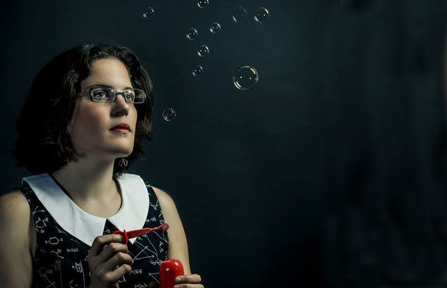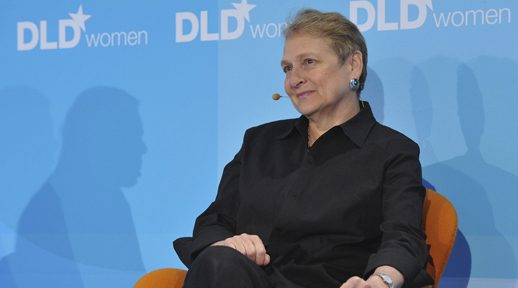Innovation keynote speaker and expert, Dr. AnnMarie Thomas works (and plays) to empower, support, and inspire today’s innovators, engineers, and inventors, as well as those of tomorrow. A seasoned maker, tinkerer, and educator, Dr. Thomas heads the Playful Learning Lab at the University of St. Thomas, where her research group explores how to integrate joy into learning and working as they partner with an eclectic network of collaborators that includes chefs, circus performers, and pre-schoolers. She is the inventor of Squishy Circuits – a homemade play-do that helps children learn how to build electrical circuits and is now used worldwide by teachers and parents to introduce children to electrical engineering.

THOMAS: Play allows us to focus on process and be present in the moment, as opposed to working towards a pre-determined outcome. You’re not under pressure to have the “perfect” solution when you’re playing. Instead, you are expected to be present in the moment, respond immediately to what is happening and enjoy the process.
When we are playful and exploring, then, we are more likely to enter a creative space where new and unexpected ideas present themselves. In fact, success often comes when companies and individuals do something different and surprising.

THOMAS: You can’t force playfulness. It’s not like asking people to work out at least twenty minutes each day on a treadmill. Providing time to play does not necessarily mean play will occur. Instead, organizations need to nurture a culture that allows for whimsical moments and actions that aren’t immediately tied to a necessary project goal or outcome. If you’re in a CEO or project management position, you need to lead by example.
Many parents and executives have probably used the phrase “Stop playing around and get to work” at some point. Well, we need to reframe the concept of “play.”
I often talk about the difference between being “childish” and “child-like.” We should want our employees to be child-like in how they approach the world. Young children are actively questioning and testing the world around them, looking for the limits and testing the “what ifs.” Children are less influenced by pre-conceived notions of the “right way” to do things and thus come up with unusual solutions to seemingly simple, or even boring, challenges.

THOMAS: A “maker” is someone who finds joy in making things- be it robots, cookies, furniture, gardens, clothing, stories, or anything else. The Maker Movement is a social movement of inventors, designers, and creators that are not confined a specific discipline, so then a Maker Faire is not “just” a robot show, or “just” an art show. Rather, it’s a gathering where a broad array of skills and talents are showcased in a way that spurs collaboration and cross-disciplinary endeavors. This mashing up of skills and knowledge sets from different fields creates a rich space where innovation can blossom.

THOMAS: One rut that many people fall into is trying to replicate prior success – be it their own or that of a competitor – by copying it as closely as possible. Students are taught business and technical solutions that have worked in the past, and all too often think that if a method worked once then it is the “correct” way. However, we live in a rapidly changing world, and yesterday’s norms may not be relevant tomorrow. We need creative solvers who are willing to develop and try new solutions. I worry that our current education systems and testing structures, as well as the super-scheduled nature of many American children’s childhoods, are not always conducive to developing this sort of flexible, creative thinking.

THOMAS: You’re never too old to learn something new. Every new skill you acquire or new piece of information allows you to approach your work differently. Doing things the “way we’ve always done them” can be a dangerous habit to get into. To counter this, it’s important to always be seeking out exposure to new ideas and concepts. The maker movement really embraces this ethos. Makerspaces and maker organizations are typically very welcoming to newcomers who want to try a new tool or project.

THOMAS: In my work interviewing makers and innovators from around the world, I was surprised at how many common traits and experiences kept showing up in their stories. Sure, there was curiosity and playfulness, but just as present were stories of repurposing materials for new uses and sharing information and ideas – characteristics which are at the heart of the open source software and hardware movements we are seeing today. That sense of generosity that many makers have with their time, resources, and knowledge can be traced back to their childhoods.
On a side note, the eight common traits that I write about in my book are: Playfulness, Generosity, Resourcefulness, Curiosity, Risk-taking, Responsibility, Persistence, and Optimism.

THOMAS: It’s a myth that if you get good grades in school you’ll automatically be successful in life. Similarly, “bad grades” don’t mean you’re doomed to fail. We need to recognize that every individual will have their own unique learning path. We often overemphasize the importance of “good grades” without considering what those grades are really telling us about a student.

THOMAS: Teachers, especially K-12 teachers, are my heroes. They have an unbelievable amount of responsibilities and very little time. Sadly, they often also lack support. My advice is to work with what you have. A hands-on project doesn’t have to be complex. You don’t need a 3D printer or fancy tools. It’s amazing what kids (and adults) can do with some pipe cleaners or wood.

THOMAS: I had long been interested in the intersection of art and technology, and really wanted a fun way to introduce my children to electrical circuits. Hence, Squishy Circuits was born. From the very beginning of the project we wanted it to be very transparent and share all of our steps and information with others.
After giving a talk about the project at TED, I was amazed at how quickly the project took off. I’ve heard of people – teachers, parents, students, museums, and libraries- around the world making the project their own and incorporating it into their work. This makes me so incredibly happy. My only hope for the project was to put it out into the world and see what people would do with it. It turns out that people are doing amazing things with it!
To bring creativity keynote speaker Dr. AnnMarie Thomas to your organization, please contact Michael Frick at: Mike@Speaking.com
© SPEAKING.com, published on June 17, 2018







Leave a Reply